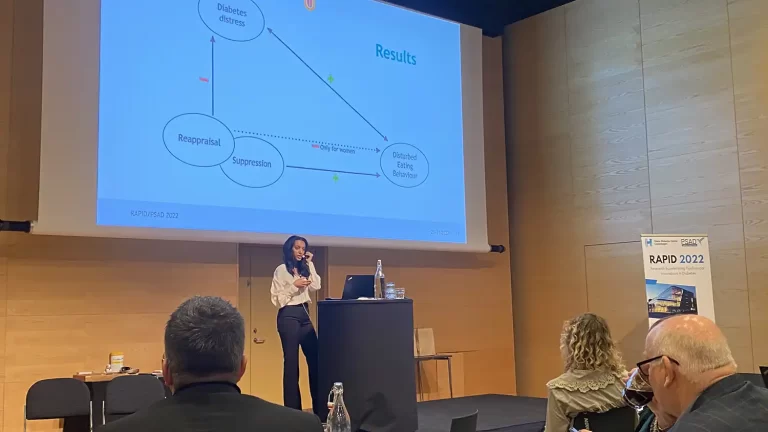By Nicole Walker
Disclaimer
The content in this article is not intended to be a substitute for professional medical advice and should not be relied on as health or personal advice. Always seek the guidance of your doctor or other qualified health professional with any questions you may have regarding your health or a medical condition.
Christmas day is a tricky day for anyone with dietary needs, but diabetes in particular. The unpredictability of food, alcohol, heat (in the southern hemisphere at least!), spontaneous Christmas backyard cricket or beach swims make it near impossible to keep your Blood Glucose Levels (BGLs) smooth. So, let’s not aim for perfection. Let’s just aim to avoid the extremes such as pesky hypos and symptomatic higher BGLs leaving you thirsty and tired so you can enjoy your family and friends on Christmas day. Here are some tips to make life a little easier with Type 1 Diabetes on Christmas day!
Think about how your Christmas day looks, what are the likely bigger Christmas day meals and what food does your Christmas traditionally have? Will there be lots of nibbles, 3 courses, lots of dessert that you love? Will you be moving around to 2-3 different family groups and meals on the same day? Will you be having a hot meal with roast vegetables or BBQ / seafood and salads? Do you enjoy alcohol on Christmas day? Do you tend to do any activities on Christmas day like beaching, swimming in the pool, running around with the kids and their toys, going for an evening walk or a super early morning road ride?
Tip 1. Nibbles.
Bring along a plate of low carb nibbles that you don’t have to dose for (see ideas here) or other examples: seafood like prawns, oysters or mussels or easily carb countable snacks such as Jatz crackers with a low carb topping like salmon, cream cheese and capers or a variety of yummy cheeses or dark chocolate coated nuts. Steer clear of things like chips and chocolates that are hard to quantify how much you are having. If you choose to eat carbs at this time – decide how much to have, gather it on a little side plate perhaps, carb count, dose and enjoy! Deciding how much and what to eat will help to also pace yourself for the meal itself!
Tip 2. Dose for each course separately.
Yes, that is right. Dose for entrée/nibbles, then again for the main and then the dessert on a pump AND on injections. Three eating occasions, three doses. This is because insulin is designed to work best when you dose within 20min (ish!) to immediately before a meal therefore each dose will absorb the glucose from the meal as best as possible.
Want to avoid giving three doses?
Dosing up front for all courses could result in a hypo if you dose too much insulin too early when the main and dessert are a good hour or two away.
Dosing at the last course will likely mean your BGL runs high and you will likely need a correction. This is a sure way for your BGLs to be a bit wild all day and making it tricky to catch up.
Having low carb snacks prior to the meal will reduce your doses to just two! Or perhaps you are not such a fan of the dessert – consider choc dipped strawberries or some nice cheese on low carb crackers and you might only need to dose for the main meal.
If you have a big beautiful three course Christmas lunch – let’s be realistic most wouldn’t want dinner after that. So how about having a low carb dinner later on, just a salad and leftover meat or omelette for dinner. If we get Christmas lunch dosing right you might not need a correction or a food dose at this time!
Tip 3. Offer to bring the potato salad.
Bring along the hardest dish to carb count that you love such as the potato salad, trifle or pavlova. Then practice the recipe before Christmas day, carb count it and also practice dosing for and eating it! This gives you a chance to know the carbs for your usual portion and then be able to give a good shot (no pun intended) at an accurate dose for the day.
Tip 4. Consider having less insulin if you are drinking more than 2 standard drinks of alcohol.
Alcohol can increase risk of a hypo later on in the day so consider if you need to reduce your insulin dose 20-30% (or what you know from experience) with the meal if you are drinking more than 2 standard drinks. Less than 2 doesn’t tend to have enough of an effect on your BGLs to need to reduce your dose for most people, but it is individual. It does depend what you are drinking– if you enjoy sugar free mixers, spirits on the rocks, dry wine or a light beer these are more likely to drop your BGLs later in the day when you have more than 2 standard drinks (not two of your usual wine pours!). If you enjoy sweet drinks such as mulled wine, port, dessert wine, cider, full sugar mixers, cocktails or pimms then these may increase your BGLs and you may need to consider a small dose to cover the sugar. We are only talking 1-2 units for every couple of drinks because keep in mind that the alcohol part will still potentially drop your BGL later on so avoid giving a full dose based on the carbs.
Tip 5. Consider having less insulin or some Christmas snacks without insulin if you are going to have an active Christmas day
Exercise and activity can also reduce your BGLs and remember that running around with the kids on their new bike, playing in the pool, walking to other people’s places for lunch and backyard cricket are all forms of activity that will potentially reduce your BGLs. If you can plan for it – great! Consider reducing your insulin for the meal or course before the activity by 20-50%. If it is spontaneous, (and let’s be honest this is mostly what happens at Christmas!) then keep the Christmas snacks handy that have some carbohydrates for example: fruit salad, chocolates, crackers or chips, even a couple mouthfuls more of the potato salad and eat them without insulin. Consider in roughly 15g portions “Exercise carbs” and have 1 x 15g exercise carb to get your BGL up >7mmol/L before the activity. Check your BGLs every 30mins and have 1 x 15g exercise carb per 30-60mins of exercise to maintain your BGLs >7mmol/L. See here for more info on exercise and diabetes.
In Summary – don’t forget to enjoy Christmas day!
Ultimately Christmas day with Type 1 Diabetes is tricky, but it is still Christmas day so don’t let your diabetes get in the way! It is probably one of the hardest days of the year to manage because of all the food, activity and other variables that can make your BGLs go any which direction throughout the day. Be kind to yourself and remember to enjoy the day with family and friends. They care for you too and therefore it is also ok to take some time out from the socialising to carb count, do a test or an insulin injection in a peaceful other room or bring along easier carb counting foods if you need just to keep diabetes at bay. Remember if it all turns to trifle just get yourself safe before bed and there will always be another day tomorrow!
Merry Christmas!
From your Dietitian at Macintyre Health



